What Is an Accessible Document Flywheel and Why It Matters for Your Organization
Learn the advantages of a systematic, self-sustaining approach to addressing PDF accessibility
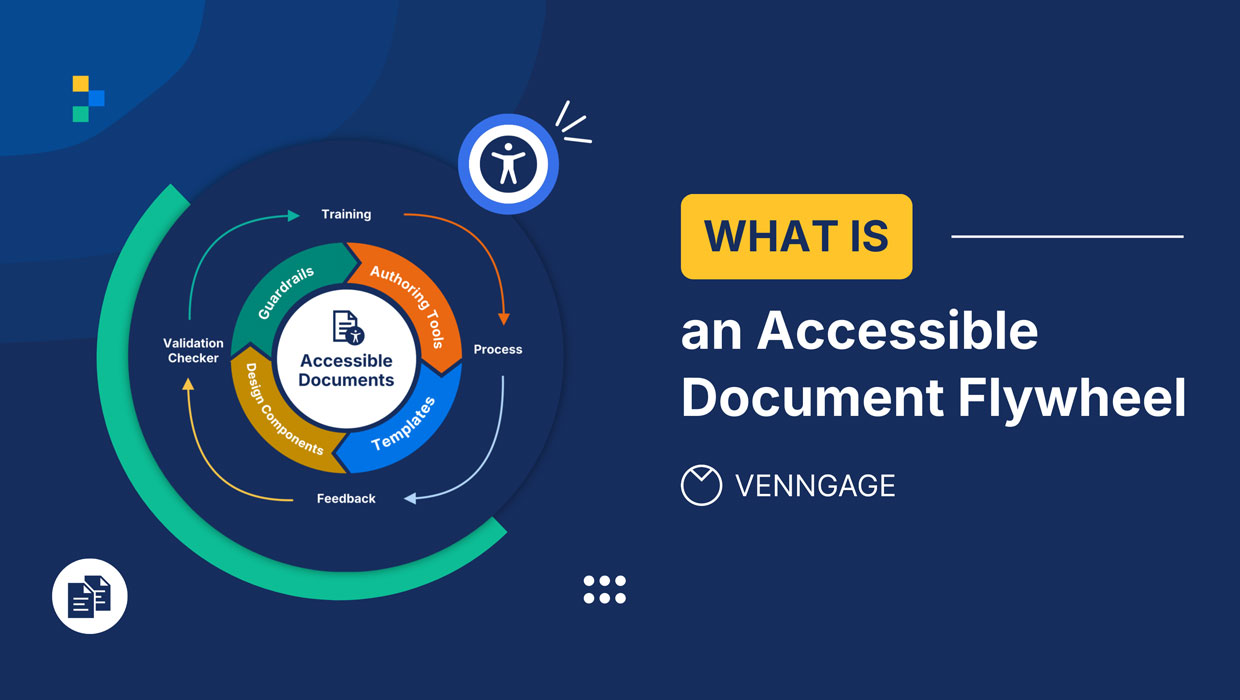
PDFs are everywhere. Businesses, universities, and government agencies create thousands of them every month. These documents often include reports, research papers, and forms. However, a significant issue persists. Many PDFs are not accessible to people with visual or reading disabilities.
This creates real challenges. People with disabilities struggle to complete tasks, access important information, or maintain independence. A report by Google for Education found that over 360 billion PDFs globally are not compatible with screen readers.
This problem will only grow unless organizations rethink how they create PDFs. In this article, we will explore a long-term solution: the Accessible Document Flywheel. It is a systematic, self-sustaining approach to addressing PDF accessibility.
So What is an Accessible Document Flywheel?
The term “flywheel” is a concept borrowed from business strategy. A flywheel is a self-reinforcing system that gains momentum over time.
You must have heard of Amazon’s flywheel, a powerful business model that has fueled its remarkable growth over the years. The concept behind Amazon’s flywheel is simple — yet incredibly effective. By focusing on continuously improving the customer experience, Amazon drives more traffic to its platform.
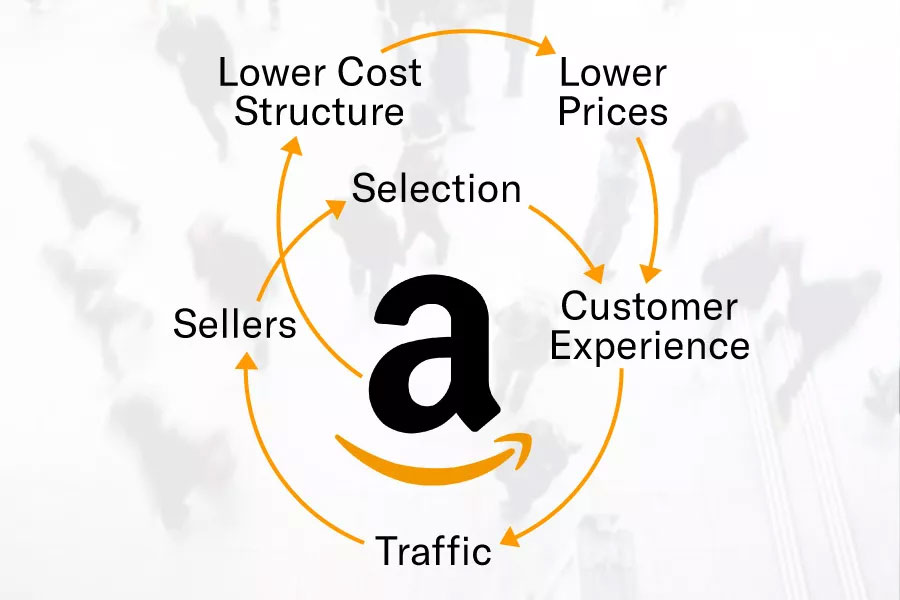
This increased traffic attracts more sellers who want to tap into Amazon’s vast customer base. With more sellers offering a broader range of products, competition increases, which in turn helps to lower prices and costs. This creates an even better experience for customers, as they benefit from lower prices and a wider selection.
Satisfied customers then return to Amazon, attracting even more traffic and further fueling the cycle. This flywheel creates a self-reinforcing loop where each component feeds into the next, propelling Amazon’s growth.
Amazon’s flywheel is a prime example of how focusing on one key area — in this case, customer satisfaction — can set off a chain reaction that leads to exponential success.
HubSpot employs a similar flywheel strategy to great effect. Instead of relying on outbound marketing and paid advertising, HubSpot focuses on delivering exceptional experiences to its customers, which encourages them to spread the word. Happy customers become advocates, generating organic word-of-mouth marketing that attracts new users.
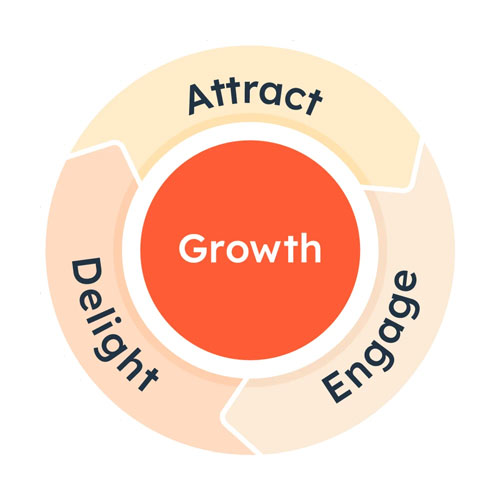
This flywheel creates a cycle where satisfied users keep the system in motion, helping HubSpot expand its reach without having to spend heavily on traditional marketing campaigns.
HubSpot also focuses on retaining its existing customers by offering them valuable content, training, and support, ensuring that customers not only stay engaged but also advocate for the brand. Like Amazon, HubSpot’s flywheel is self-sustaining and continues to build momentum over time, resulting in long-term growth and a loyal customer base.
When applied to document accessibility, the flywheel focuses on creating a culture where accessibility is a built-in feature rather than a reactive measure.
The Accessible Document Flywheel is a model that promotes the continuous creation and maintenance of accessible PDFs by embedding accessibility standards directly into the document creation process.

Over time, this system reduces the reliance on extensive remediation, helps reduce the backlog of inaccessible PDFs and ensures a more inclusive document landscape.
Why the Existing Approach to Accessibility is Broken
Currently, many organizations treat accessibility as an afterthought. They create documents first, and then, if accessibility issues are discovered, they fix them later.
This approach is like shooting an arrow first and drawing a bullseye around it. Organizations aim at creating documents without considering accessibility upfront, and only later do they try to fix any issues that arise. Instead of planning for accessibility from the start, they aim for perfection after the fact, which often leads to inefficiencies and missed opportunities.
The remediation process is often handled by a small team of specialists after the document is published. However, this reactive approach is inefficient, ineffective, and costly.
According to a survey by WebAIM, 72% of blind and low-vision assistive technology users reported that inaccessible PDFs hindered their ability to work or study. 60% said these documents created barriers to managing daily life. Alarmingly, 14% of respondents encountered such issues over 20 times a month. These statistics illustrate the scale of the problem.
One of the primary reasons why the current approach isn’t working is the sheer volume of documents being created daily. Even if teams of accessibility experts worked around the clock, the backlog of inaccessible documents would continue to grow. It’s like trying to empty a sinking boat with a teaspoon.
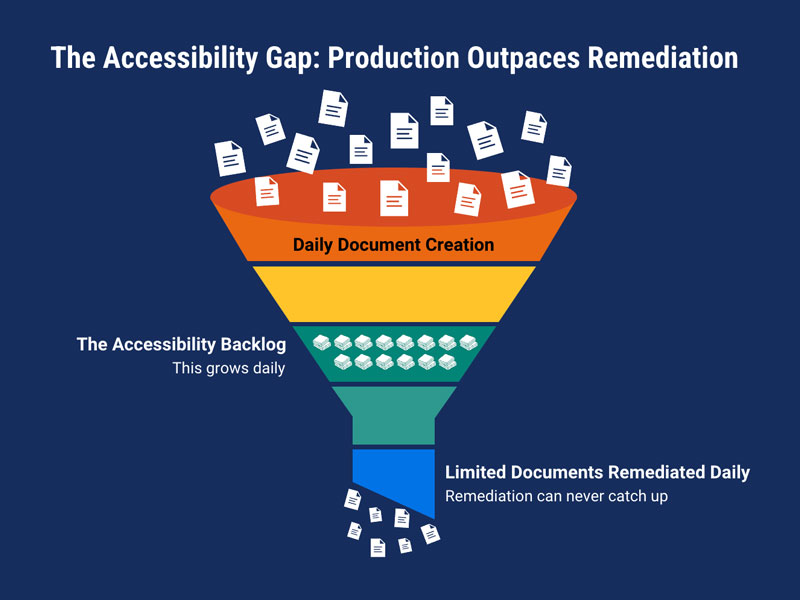
This process lacks scalability and sustainability. Instead of continually fixing existing PDFs, organizations need to rethink the way they create documents from the very beginning.
A New Approach: Start with Accessibility from the Beginning
The solution isn’t to fix PDFs faster. The solution is to ensure that PDFs are accessible from the start. This is where the Accessible Document Flywheel comes in.
The flywheel concept is about creating self-reinforcing momentum. The more accessible documents are created, the fewer issues arise in the future. As organizations move from a reactive approach to a proactive one, accessibility becomes a seamless part of the document creation process. Over time, this self-sustaining system ensures that fewer resources are required for remediation, allowing teams to focus on other, high-priority tasks.
In the Accessible Document Flywheel, the process starts small and grows larger over time — creating a virtuous cycle of accessibility improvements. It also trains you to aim and hit the bullseye with perfect precision on the first shot.
How the Accessible Document Flywheel Works
The flywheel model creates a positive feedback loop, where accessibility becomes a part of the culture rather than something that is added after the fact. Here’s how it works:
Accessible Documents from the Start
Accessibility needs to be integrated into the document creation process from the very beginning. This means ensuring that all new PDFs adhere to accessibility standards, such as clear headings, alt text for images, and logical document structure. By establishing accessibility as a default requirement, your organization can significantly reduce the amount of remediation work needed.
Reduced Workload for Remediation Teams
As accessibility standards are adopted universally, the need for remediation shrinks. The responsibility shifts from a small group of specialists to everyone involved in document creation. This significantly reduces the workload for accessibility teams and ensures that accessibility is everyone’s responsibility.
Self-Sustaining Momentum
Over time, the process of creating accessible documents becomes second nature. As more team members adopt accessible design practices, the amount of oversight required decreases, and the need for remediation becomes an exception, not the norm.
Steps to Create the Accessible Document Flywheel
Building the flywheel requires a two-step approach: First, focus on creating accessible new documents. Second, address the backlog of inaccessible PDFs that have already been created.
Step 1: Start with New Documents
The first step is to establish a system where all new PDFs are created with accessibility in mind. This includes:
- Using Accessible Templates: Create templates that integrate accessibility features such as good color contrast, clear fonts, and headings that are logical and hierarchical.
- Clear Guidelines: Establish clear guidelines for creating accessible documents. This could include checklists or templates that ensure all documents meet the required accessibility standards.
- Real-Time Accessibility Tools: Implement tools that check accessibility in real-time, helping creators identify and fix issues as they create the documents.
Step 2: Manage the Backlog
For the backlog of inaccessible documents, organizations should prioritize their remediation efforts based on usage frequency. Here’s how to manage the backlog:
- Automate Where Possible: Simple accessibility fixes, such as adding alt text to images or fixing document headings, can be automated using tools like Adobe Acrobat Pro or other PDF editing software.
- Manual Remediation: For more complex cases, manual remediation may be required. This may involve adjusting tables, forms, or non-text content to ensure it is fully accessible.
- Continuous Monitoring: Regularly review existing documents and make adjustments where necessary. This ensures that accessibility standards are maintained across the board.
5 Steps to Build the Flywheel
Creating accessible PDFs is not just a legal or moral obligation; it is a business necessity. Here are five steps to set up the Accessible Document Flywheel in your organization:
Step 1: Update Your Tools
Ensure that the software your team uses for document creation supports accessibility features. For instance:
- Microsoft Word includes built-in tools for creating accessible documents, such as alt text for images, proper heading styles, and more.
- Venngage offers accessible templates and built-in accessibility checkers to ensure all documents meet compliance standards.
Step 2: Design Accessible Templates
Create templates that combine branding with accessibility. These templates should include:
- Clear Typography: Choose legible fonts with sufficient contrast against the background.
- Logical Heading Structures: Use headings in a hierarchical order to help users navigate the document easily.
- Accessible Hyperlinks: Ensure all hyperlinks are descriptive and lead to accessible content.
Step 3: Establish Processes for New PDFs
Set up clear processes to ensure that all new documents meet accessibility guidelines. This can include:
- Checklists: Provide teams with checklists to guide them through the process of creating accessible documents.
- Regular Reviews: Implement regular reviews of new documents to ensure they meet accessibility standards.
Step 4: Validate Accessibility Before Publishing
Use automated accessibility checkers to identify any issues, such as missing alt text or incorrect heading structures, before documents are published. Tools like the Microsoft Accessibility Checker or Venngage’s free Accessbility PDF Checker can help flag issues early in the process.
Step 5: Train Your Team
Provide ongoing training to your team to ensure they understand accessibility requirements and how to create accessible documents. This could include:
- Workshops: Run regular workshops or webinars on accessibility best practices.
- On-Demand Resources: Offer guides, templates, and tutorials for staff to reference when creating accessible documents.
Real-World Examples of the Flywheel in Action
Several organizations have successfully implemented accessibility-focused processes that align with the Accessible Document Flywheel:
Chadsan Financial Services
Chadsan Financial Services uses Venngage’s accessible templates and tools to create compliant documents without requiring extensive remediation. This allows the company to focus its resources on more strategic tasks, freeing up time and energy for growth.
Colorado State University
Colorado State University has embraced accessibility as a priority. They have created accessible templates and trained their staff on best practices for document accessibility. This ensures consistent compliance with electronic accessibility standards.
Here’s an example of ??Venngage’s accessibility-friendly templates. Venngage’s built-in accessibility tools automatically detect accessibility issues as you work and provide real-time recommendations to help you create more accessible content.
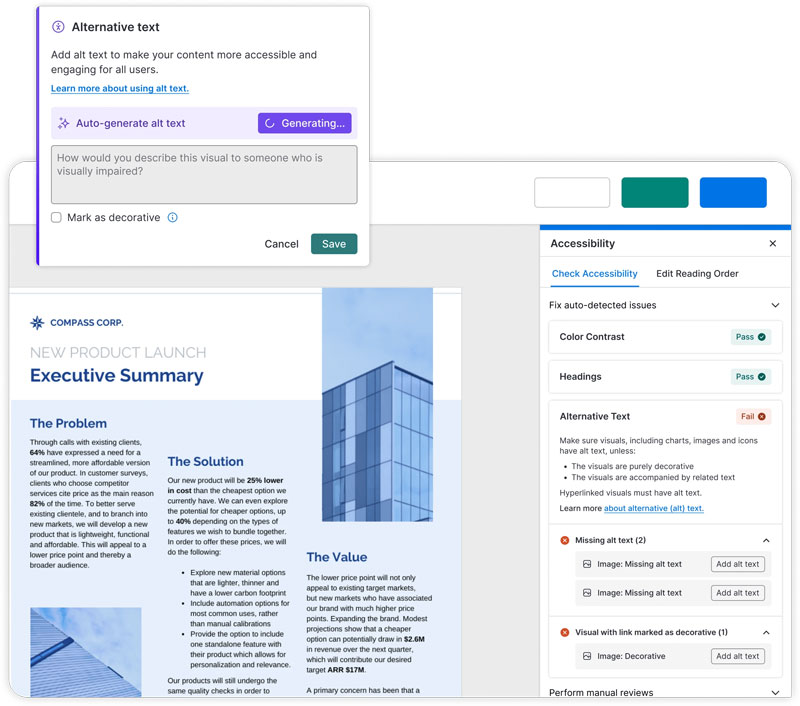
University of Southern California
USC has fostered a culture of continuous learning. The university offers workshops and online training sessions to ensure that all staff members are equipped to create accessible PDFs consistently.
These examples demonstrate that with the right systems and tools in place, accessibility can be achieved at scale, benefiting both the organization and its stakeholders.
The Benefits of the Accessible Document Flywheel
Adopting the flywheel approach offers several long-term advantages:
1. Reduced Backlog
With accessibility integrated into the document creation process, the need for constant remediation is minimized. Remediation teams can focus on high-priority tasks rather than continually fixing documents.
2. Inclusive Content
Accessible PDFs ensure that everyone, regardless of their abilities, can access the information. This helps organizations create more inclusive and equitable digital experiences.
3. Legal Compliance
Many regions now require organizations to meet accessibility standards. The flywheel approach helps ensure compliance with laws such as the Americans with Disabilities Act (ADA) and Section 508, reducing the risk of legal issues.
4. Sustainable Practices
Accessibility becomes a part of the organization’s culture, making it easier to maintain over time. This leads to more efficient and sustainable business practices.
Building Accessibility Into Every Document Creation Process
Incorporating accessibility into the document creation process from the beginning is not only the right thing to do but also a smarter, more efficient approach. When accessibility becomes a natural part of your workflow, it sets the stage for a smoother process, fewer mistakes, and more inclusive content.
This method helps organizations avoid costly, time-consuming fixes later, making accessibility a seamless part of everyday operations. By creating accessible documents as part of your regular routine, you are effectively future-proofing your content strategy and making it much easier to meet legal and ethical standards.
One of the easiest ways to kickstart your accessible document creation journey is by using tools designed with accessibility in mind. Venngage’s accessibility templates are an excellent starting point. These templates are built to meet accessibility standards right out of the box, ensuring that your team can quickly produce documents that are accessible and compliant.
Whether you are creating reports, presentations, or any other type of document, Venngage’s templates will help you integrate accessibility into your workflow with ease.
Start creating accessible documents today. Explore Venngage’s accessibility templates and make inclusivity a core part of your document creation process.Interested in building an Accessible Document Flywheel for your organization? Schedule a demo with Venngage to discover how their tools can help.
This article was last modified on May 29, 2025
This article was first published on December 2, 2024




